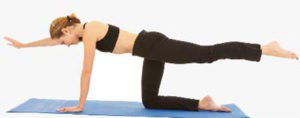By Michael E. Kriz, PT, DPT, OCS, CFMT
 The phrase “Core Stability” is used a lot by all disciplines involved in health and wellness. In our twenty years of experience as physical therapists we have seen that the definition of “the core” is highly variable but most often includes the abdominals. The core muscles attach to, and stabilize, the spine, the rib cage and the pelvis. The muscles combined are thought to construct a cylinder that allows for pressure to be built in the abdominal region that provides stability.
The phrase “Core Stability” is used a lot by all disciplines involved in health and wellness. In our twenty years of experience as physical therapists we have seen that the definition of “the core” is highly variable but most often includes the abdominals. The core muscles attach to, and stabilize, the spine, the rib cage and the pelvis. The muscles combined are thought to construct a cylinder that allows for pressure to be built in the abdominal region that provides stability.
The definition of the core from our perspective is as follows:
1. Comprised of the following muscles:
i. Transverse Abdominus – the deepest abdominal muscle – the outside wall of the cylinder
ii. Diaphragm – the top of the core’s cylinder
iii. Pelvic floor muscles – the bottom of the cylinder
iv. Iliopsoas (often referred to as the psoas)
v. Multfidii – small muscles along the back of the spine
2. Provides a solid foundation (when efficient) on which the arms, legs and trunk move
3. Requires that the framework (skeleton) is efficiently aligned, that is to say: “posture is KING!”
Injury, pain and habitual posture all affect the speed, strength and endurance of core muscles so it is important to take care of and be aware of anything that may affect them.
The theory of instability of the lumbar spine and pelvis rests, in some part, on the inefficient contraction of core muscles that allow the vertebrae to move excessively and in a relatively uncontrolled fashion causing shearing, compression or tearing forces on the tissues of the spine including the ligaments, muscles, fascia, nerves and blood vessels that provide support and nourishment to the spine. If spinal instabilities are left unaddressed for even short periods of time, degeneration of the spine may occur. Pain and weakness often follows but it make take weeks, months or years to manifest. Nagging, persistent little aches and pains in the back, hips and legs are often associated with these dysfunction.
The theories of stabilizing the spine focus on strengthening the core muscles so that they can prevent the excessive movements of the spine and the “wear and tear” associated with it. Across the spectrum of physical therapy and personal training one can find a wide variety of exercises directed at strengthening the core. The difficulty is choosing the appropriate exercises to be done at any given time in a training program.
Research is now demonstrating that the core is effectively contracted when our parts (head, neck, rib cage and pelvis) are stacked on top of each other…again, posture is King! When muscles are either stretched or shortened from posture habits such as standing with the back hyperextended and, most commonly seen, sitting like “a boiled shrimp”, they are unable to contract at the correct time, with enough force or long enough to stabilize the spine when we sit, stand or perform daily tasks, much less when we play a sport.
Standing straight, as many of us were told to do by our parents, may actually place the rib cage in a slight backward tilt rendering the core less responsive. Learning to stack the rib cage appropriately over the pelvis is one small step to improving the core response. Remember that habits are often deeply ingrained and require frequent corrections. Depending on the severity of the habit, those corrections may have to be performed every few minutes, hour, day and weeks to implement. Even when we think that the old habits are broken, we may find ourselves lapsing into the old habitual postures, especially when tired or under stress.
A well trained Functional Manual Physical Therapist can help guide you through the morass of posture changes and exercises that you will need to make your core muscles responsive and strong so that you are able to do what you want with better strength and endurance and reduce the potential for injury.
Contact Kriz Physical Therapy Today!
Functional Manual Physical Therapist
27180 Bay Landing Drive, Ste. 7
Bonita Springs, FL 34135
(239) 992-6700
krizpt1@gmail.com
www.krizphysicaltherapy.com









